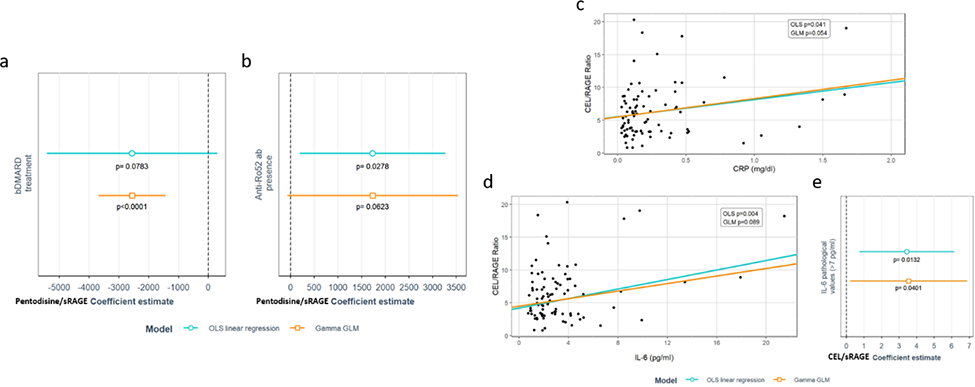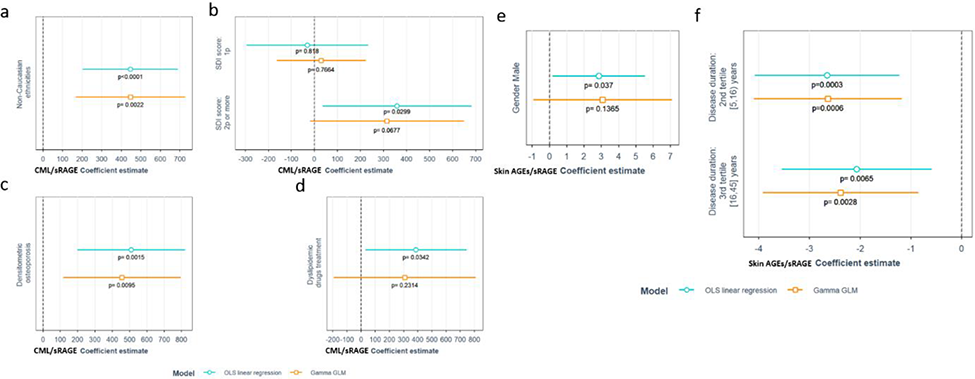

Background: It has been postulated that the axis of advanced glycation end-products (AGEs) and their soluble receptor (sRAGE) could play a relevant role as inducers in the chronic inflammatory pathway in various conditions; among them, in systemic lupus erythematosus (SLE). However, some authors 1 defend that the ratio AGEs to RAGE could be a better and universal biomarker than them individually.
Objectives: As the ratios between AGEs and sRAGE have not been studied in SLE, the aim of this project is to perform an exploratory analysis of their associations with SLE characteristics.
Methods: Multiple demographic and clinical characteristics of the 122 SLE patients who signed the informed consent were recorded. Skin AGE concentrations were measured by skin autofluorescence and serum AGEs and sRAGE were measured through ELISA according to the manufacturer instructions. The relationship between the different serum AGEs (pentosidine, CML and CEL) and sRAGE was analyzed using both an OLS regression model and a GML as all the ratios followed a non-normal distribution. All were adjusted for confounders based on previous bivariate analysis.
Results: Figures 1 and 2 show the statistically significant associations between each of the ratios and SLE characteristics. We found a lower pentosidine/sRAGE ratio in patients on bDMARDs (Figure 1a) and a higher one in anti-Ro52+ patients (Figure 1b). Higher ratios of CEL/sRAGE (Figure 1c-e) and CML/sRAGE (Figure 2a-d) were associated with higher markers of activity and damage, while higher skin AGEs/sRAGE ratio were associated with male sex (Figure 2d) and lower one with shorter disease duration (Figure 2e).
Conclusion: Most of these associations, although preliminary and not intended for drawing conclusions, support our hypothesis that the different ratios between AGEs and sRAGE could also have implications, and maybe used as biomarkers, related to patients phenotypes, response to treatment, activity and prognosis. However, these observations should be further explored.
REFERENCES: [1] Prasad K, Dhar I, Caspar-Bell G. Role of advanced glycation end products and its receptors in the pathogenesis of cigarette smoke-induced cardiovascular disease. Int J Angiol. 2014;24(2):75–80.
Pentosidine/sRAGE (a-b) and CEL/sRAGE (c-e) statistically significant associations with SLE

CML/sRAGE (a-d) and skin AGEs/sRAGE (e-f) statistically significant associations with SLE

Acknowledgements: This work was supported by the Instituto de Salud Carlos III (ISCIII) and the European Union (Grant number “PI18/00059”), by the Fundación Española de Reumatología through the Ayuda a la Intensificación de la Actividad Investigadora awarded in 2021 and by a Jordi Gras scholarship awarded by the Hospital del Mar Research Institute from 2019 to 2021. We would also want to thank Dr. Isaac Alarcón Valero for his statistical support.
Disclosure of Interests: None declared.